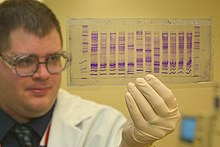DNA profiling
The first patent covering the direct use of DNA variation for forensics (US5593832A[6][7]) was filed by Jeffrey Glassberg in 1983, based upon work he had done while at Rockefeller University in the United States in 1981.British geneticist Sir Alec Jeffreys independently developed a process for DNA profiling in 1984 while working in the Department of Genetics at the University of Leicester.In the murder inquiry, led by Detective David Baker, the DNA contained within blood samples obtained voluntarily from around 5,000 local men who willingly assisted Leicestershire Constabulary with the investigation, resulted in the exoneration of Richard Buckland, an initial suspect who had confessed to one of the crimes, and the subsequent conviction of Colin Pitchfork on January 2, 1988.[15] The admissibility of DNA evidence in courts was disputed in the United States in the 1980s and 1990s, but has since become more universally accepted due to improved techniques.[19] PCR, or Polymerase Chain Reaction, is a widely used molecular biology technique to amplify a specific DNA sequence.Homicide victims are frequently left exposed to harsh conditions before they are found, and objects that are used to commit crimes have often been handled by more than one person.This method is gaining attention due to Trade Related Intellectual property rights (TRIPs) and the Convention on Biological Diversity (CBD).[45] The United Kingdom maintains the National DNA Database (NDNAD), which is of similar size, despite the UK's smaller population.The size of this database, and its rate of growth, are giving concern to civil liberties groups in the UK, where police have wide-ranging powers to take samples and retain them even in the event of acquittal.[46] The Conservative–Liberal Democrat coalition partially addressed these concerns with part 1 of the Protection of Freedoms Act 2012, under which DNA samples must be deleted if suspects are acquitted or not charged, except in relation to certain (mostly serious or sexual) offenses.It manages huge amount of microsatellite DNA fingerprint data, performs genetic studies, and automates collection, storage and maintenance while decreasing human error and increasing efficiency.The system may be tailored to specific laboratory needs, making it a valuable tool for plant breeders, forensic science, and human fingerprint recognition.[60] Familial DNA database searching was first used in an investigation leading to the conviction of Jeffrey Gafoor of the murder of Lynette White in the United Kingdom on 4 July 2003.A wider search found a partial match to an individual; on being questioned, this man revealed he had a brother, Craig Harman, who lived very close to the original crime scene.[65] It was not a witness or informant that tipped off law enforcement to the identity of the "Grim Sleeper" serial killer, who had eluded police for more than two decades, but DNA from the suspect's own son.When his DNA was entered into the database of convicted felons, detectives were alerted to a partial match to evidence found at the "Grim Sleeper" crime scenes.[66] More recently, familial DNA led to the arrest of 21-year-old Elvis Garcia on charges of sexual assault and false imprisonment of a woman in Santa Cruz in 2008.Aaron Thomas, the suspected East Coast Rapist, was arrested in connection with the rape of 17 women from Virginia to Rhode Island, but familial DNA was not used in the case.[50] For instance, investigators with Denver District Attorney's Office successfully identified a suspect in a property theft case using a familial DNA search.In this example, the suspect's blood left at the scene of the crime strongly resembled that of a current Colorado Department of Corrections prisoner.Critics of this practice underline that this analogy ignores that "most people have no idea that they risk surrendering their genetic identity to the police by, for instance, failing to destroy a used coffee cup."[78] The United States Supreme Court ruled in Maryland v. King (2013) that DNA sampling of prisoners arrested for serious crimes is constitutional.[79][80][81] In the United Kingdom, the Human Tissue Act 2004 prohibits private individuals from covertly collecting biological samples (hair, fingernails, etc.)In 1996 R v. Doheny[84] Juries should weigh up conflicting and corroborative evidence, using their own common sense and not by using mathematical formulae, such as Bayes' theorem, so as to avoid "confusion, misunderstanding and misjudgment".[85] In R v Bates,[86] Moore-Bick LJ said: We can see no reason why partial profile DNA evidence should not be admissible provided that the jury are made aware of its inherent limitations and are given a sufficient explanation to enable them to evaluate it.[90] The New York Times quoted the lead author, Daniel Frumkin, saying, "You can just engineer a crime scene ... any biology undergraduate could perform this".[92] Researchers at the University of Tokyo integrated an artificial DNA replication scheme with a rebuilt gene expression system and micro-compartmentalization utilizing cell-free materials alone for the first time.[93] On July 7, 2008, the American chemical society reported that Japanese chemists have created the world's first DNA molecule comprised nearly completely of synthetic components.On gold nanoparticles, functional peptides and tiny molecules referred to as synthetic transcription factors, which imitate the various TF domains, were attached to create Nano Script.[94] Three different fluorophores—red, green, and blue—were carefully fixed on the DNA rod surface to provide spatial information and create a nanoscale barcode.






Genetic testingDNA phenotypingForensic sciencePhysiologicalAnthropologyBiologyBloodstain pattern analysisDentistryForensic genealogyEntomologyEpidemiologyLimnologyMedicinePalynologyPathologyPodiatryToxicologySocialPsychiatryPsychologyPsychotherapySocial workVerbal autopsyAccountingBody identificationChemistryColorimetryElection forensicsFacial reconstructionFingerprint analysisFirearm examinationFootwear evidenceForensic artsProfilingGloveprint analysisPalmprint analysisQuestioned document examinationVein matchingForensic geophysicsForensic geologySocial network analysisDigital forensicsComputer examsData analysisDatabase studyMalware analysisMobile devicesNetwork analysisPhotographyVideo analysisAudio analysisElectrical engineeringEngineeringFire investigationFire accelerant detectionFractographyLinguisticsMaterials engineeringPolymer engineeringStatisticsTraffic collision reconstructionCrime sceneCSI effectDNA in forensic entomologyPerry Mason syndromePollen calendarSkid markTrace evidenceOutlineDNA barcodingforensiccriminal investigationspaternity testinggenealogicalAlec JeffreysColin PitchforkJeffrey GlassbergRockefeller UniversityBritishUniversity of LeicesterForensic Science ServiceNarborough, LeicestershireLeicestershire ConstabularyImperial Chemical Industriesmonozygotic (identical) twinsvariable number tandem repeatsmicrosatellitesminisatellitesrestriction fragment length polymorphism (RFLP)DNA extractionsalivaextractedorganic extractionphenol–chloroform extractionChelex extractionsolid-phase extractionDifferential extractionenzymesSouthern BlotsRestriction fragment length polymorphismPolymerase chain reactionprimersalleleselectrophoresisSTR analysisindependently assortedMitochondrial DNAProbabilistic genotypingNational DNA databaseDNA databaseUniversity of CambridgeDNA databasesUnited StatesCombined DNA Index SystemUnited Kingdomcivil libertiesProtection of Freedoms Act 2012U.S. Patriot Actmonozygotic twinschimerasopen reading framesForensic Science Internationalin vitromolecular biologyEvidenceTestimony